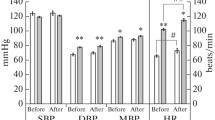Abstract
An increase in insular activity in response to hyperglycemia when performing a glucose tolerance test (GTT) during normal physical activity in eight women volunteers was found to be associated with increased blood concentrations of insulin provided by an increase in secretion rate and a decrease in inactivation rate. After 81 days of stay in long-term –6° head-down tilt bed rest (bed rest), flattened glycemic curves (with low hyperglycemic lifting) observed during the GTT, what was indicated high insular activity. An increase in the insular activity was evidencing also by a smaller peak of the blood concentration of glucose from 5 min after intravenous nfusion of 20 mL of 40% glucose solution at 120 minute of the GTT. In bed rest on empty stomach no significant changes in the concentrations of insulin and C-peptide were observed. The dynamics of hormone during the GTT was showed that the appearance of flattened glycemic curves when performing GTT during bed rest was associated with more pronounced, than under the usual conditions, an increase in insulin concentration in response to hyperglycemia. An increase in the blood insulin concentration when performing GTT in bed rest was mainly provided by increased hormone secretion rate in the pancreas, but not by a decrease in its inactivation rate. If you use regular exercises for prevention of hypokinesia under conditions of bed rest, an increase in insulin concentration during GTT was mainly provided by a decrease in its inactivation rate and not by an increase in secretion rate.
Similar content being viewed by others
References
Smirnov, K.V. and Ugolev, A.M., Kosmicheskaya gastroentroenterologiya (Space Gastroenterology), Moscow: Nauka, 1981.
Smirnov, K.V., Development of hypokinetic syndrome in the digestive system under microgravity, Fiziol. Zh. im. I.M. Sechenova, 1992, vol. 78, no. 8, p. 93.
Smirnov, K.V. and Ugolev, A.M., Digestion and absorption, in Kosmicheskaya biologiya i meditsina. Tom 3. Chelovek v kosmicheskom polete (Space Biology and Medicine, Vol. 3: Humans Spaceflights), Moscow: Nauka, 1997, book 1, p. 211.
Afonin, B.V., The effect of space flight and conditions of antiorthostatic hypokinesia of varying duration on the concentration of blood insulin, Kosm. Biol. Aviakosm. Med., 1989, vol. 23, no. 3, p. 77.
Stein, T., Schluter, M., and Boden, G., Development of insulin resistance by astronauts during spaceflight, Aviat. Space Environ. Med., 1994, vol. 65, p. 1091.
Alexandrov, A., Gharib, C., Grigoriev, A.I., et al., Tests d’hyperglycemie provoque par voie orale chez l’homme au cours d’un vol spatial de 150 jours, C.R. Soc. Biol., 1985, vol. 179, p. 192.
Afonin, B.V., The state of digestive system during longterm spaceflights and hypokinesia, Ross. Zh. Gastroenterol., Gepatol., Koloproktol., 1999, vol. 9, no. 7, p. 5.
Smirnov, K.V., Ruvinova, L.G., Afonin, B.V., et al., Functional test with carbohydrates loading in 237 days Spaceflights conditions, Kosm. Biol. Aviakosm. Med., 1999, vol. 25, no. 65, p. 6.
Afonin, B.V., Noskov, V.B., and Polyakov, V.V., The state of the digestive organs during long spaceflight, Hum. Physiol., 2003, vol. 29, no. 5, p. 561.
Afonin, B.V., Analysis of possible causes of activation of gastric and the pancreatic excretory and incretory function after completion of space flight at the international space station, Hum. Physiol., 2013, vol. 39, no. 5, p. 504.
Smirnov, K.V., Pishchevarenie i gipokineziya (Digestion and Hypokinesia), Moscow: Meditsina, 1990.
Goland-Ruvinova, L.G., Pechenkina, R.A., Goncharova, N.P., and Smirnov, K.V., Functional test with carbohydrates loading in conditions long antiortostatic hypokinesia, Kosm. Biol. Aviakosm. Med., 1996, vol. 20, no. 6, p. 41.
Afonin, B.V., Nichiporuk, I.A., Nesterov, M.A., et al., Results of ultrasonic researches pancreas and change of glycemic curves at glucose loading in long antiortostatic hypokinesia, Aviakosm. Ekol. Med., 1998, no. 3, p. 21.
Afonin, B.V., Dynamics of the glycemic profile in women in long-term antiorthostatic hypokinesia, Hum. Physiol., 2016, vol. 42, no. 4, p. 425.
Kozlovskaya, I.B., Yarmanova, E.N., and Fomina, E.V., Russian system of prevention: present and future, Aviakosm. Ekol. Med., 2013, vol. 47, no. 1, p. 13.
Kukoba, T.B. and Fomina, E.V., Axial loading of varying intensity during resistance training of cosmonauts as a countermeasure against hypogravitational disorders, Aviakosm. Ekol. Med., 2017, vol. 51, no. 1, p. 18.
Gardner, D.G. and Shoback, D., Greenspan’s Basic and Clinical Endocrinology, New York: McGraw-Hill, 1983.
Kamyshnikov, V.S., Kliniko-biokhimicheskaya laboratornaya diagnostika. Tom 2. Testy tolerantnosti k glyukoze (Clinical-Biochemical Laboratory Tests, Vol. 2: Tests on Glucose Tolerance), Minks: Knizhn. Dom, 2003.
Glantz, S.A., Primer of Biostatistics, New York: McGraw-Hill, 1981.
Ametov, A.S., Izbrannye lektsii po endokrinologii (Selected Lecturers on Endocrynology), Moscow: Med. Inf. Agenstvo, 2009.
Zvenigorodskaya, L.A., Konev, U.V., and Efremov, L.I., Evolution of the concepts on metabolic syndrome, Eksp. Klin. Gastroenterol., 2010, no. 7, p. 3.
Smirnov, A.V., Elementy endokrinnoi regulyatsii (Elements of Endocrine Regulation), Moscow: GEOTAR-Media, 2008.
Ametov, A.S., Smirnova, O.M., Shestakova, M.V., et al., β-kletka: sekretsiya insulina v norme i patologii (β-Cell: Normal and Pathological Insulin Secretion), Moscow: GEOTAR-Media, 2005.
Author information
Authors and Affiliations
Corresponding author
Additional information
Original Russian Text © B.V. Afonin, 2018, published in Fiziologiya Cheloveka, 2018, Vol. 44, No. 1, pp. 82–91.
Rights and permissions
About this article
Cite this article
Afonin, B.V. Incretion of Insulin by Pancreas and Its Inactivation in Women during Long-Term Head-down Tilt Bed Rest. Hum Physiol 44, 68–76 (2018). https://doi.org/10.1134/S0362119718010024
Received:
Published:
Issue Date:
DOI: https://doi.org/10.1134/S0362119718010024




